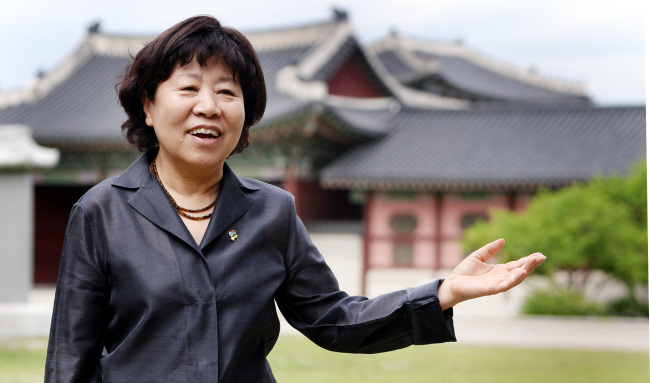On March 23, the Cultural Heritage Administration held a ceremony to mark the 15th anniversary of its foundation. Instead of festive celebrations, the state-run body marked the occasion with a solemn oath that it would change the way it has been working.
For Rha Sun-hwa, the CHA’s chief since January, it felt like the end of a chapter ― one that has been brutally tough on her and her staff ― and the beginning of a new one.
“The past five months (leading up to the anniversary) was like a ceaseless string of storms (hitting us),” she said during an interview with The Korea Herald at her Seoul office last week. She shuttles between the capital city and Daejeon, where the CHA headquarters are located.
“Now with the conclusion of a state audit (into our agency), it really feels like we’re standing at a starting point again. The beginning of a new era,” she said.
 |
| Rha Sun-hwa, chief of the Cultural Heritage Administration of Korea, poses for a photo at Gyeongbokgung Palace in Seoul before an interview last week. (Park Hyun-koo/The Korea Herald) |
After spending 35 years at a private university museum, Rha joined the CHA late last year, filling the position left vacant by predecessor Byun Young-sup amid a controversy that led to the inquiry of an unprecedented scale by the Board of Audit and Inspection.
The storm started in October with Sungnyemun, a historic gate at the center of Seoul registered as the No. 1 national treasure. The gate, which burned down in a 2008 arson attack, reopened to the public in May after five years of repair. Less than six months after the reopening, the gate’s wooden beams started cracking and its paint peeling.
Suspicions of corruption and negligence surfaced, shaking the CHA to the core. A police investigation followed, on top of the BAI audit.
The master carpenter and two CHA staff were booked on suspicion of embezzlement and bribery. The BAI, in its final report issued on May 16, ordered the CHA to re-do some of the key areas of the gate, including the paintwork, roof tiles and stonework. It concluded that the haste to meet the restoration deadline and a lack of proper oversight led to the flaws.
What happened in the past months, Rha said, forced the agency to look back on the way it has been working.
“We have never really had guidelines, principles or a philosophy of whatsoever on how we should preserve our cultural heritage,” she said. “But it wasn’t a problem until now, because people were not interested in relics. When you worry about making a living, you don’t have the luxury of worrying about the preservation of relics.”
As for Sungnyemun, when its restoration was decided, it was decided that it should be constructed in the traditional ways. But there was no consideration as to how to proceed when some of traditional materials, tools and techniques are long lost, Rha explained.
The CHA promised to introduce a series of reforms aimed at ensuring transparency, a proper oversight and a stricter adherence to principles and guidelines in the fields. Some of the measures require the amendment of existing laws.
Until the measures take their full effect, Rha is determined to go loud, yelling and screaming at people if she has to. She knows too well that it takes more than just an oath to kick an old habit.
“A fundamental change doesn’t happen overnight. It takes time,” she said. “In many fields of restoration out there, people are working the same way that they have been working for decades. Even as we speak, there are seeds of what could turn into a second or third Sungnyemun debacle being planted.”
She shows up on project sites to check for herself how the work is being carried out. So far, her assistants gave people in charge of the project an hour’s notice, but from now on she plans to turn up unnoticed.
“When it gets difficult to follow the guidelines, the craftsmen handling the restoration should consult with CHA officials and advisers, instead of making compromises here and there based on their own judgments,” she explained.
Aside from the site inspections, Rha wants to show her staff at CHA a vision that they can truly share, to motivate a fundamental change in the way they look at cultural asset management.
“We need to think of creative ways to better take care of the assets which are scattered all across the country, many of them in remote places,” she went on.
“That is why I personally believe that cultural heritage administrators should keep a close tab on the most up-to-date technologies and equipment.”
The CHA’s responsibility spans widely in time and subject matters: from the Bronze Age to today and from black rat snakes to meteorites. It has to look after them with an annual budget of only 620 billion won ($609 million).
Staff at the CHA must be efficient, too, to maximize whatever the resources available to them, she said.
“A hasty expectation is something that we must put an end to in the field of restoration, but that doesn’t mean we, at the CHA, are allowed to work slowly.”
“To change the negative public image of our agency, we need to change fast.”
By Lee Sun-young (milaya@heraldcorp.com)

